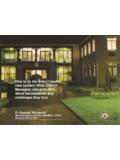Transcription of SURVEY REPORT – PRICES OF MEDICINES IN …
1 SURVEY REPORT PRICES OF MEDICINES IN LEBANONW orld Health Organization Health Action International Project on medicine PRICES Project Manager Dr. Rita KARAM AcknowledgementsWe wish to express our gratitude to World Health Organization - Health Action International project on medicine PRICES who funded the project. Our sincere thanks and deepest respect are due to: Mr. Andrew Creese, Health Economist, WHO, Essential Drugs and MEDICINES Policy Department for his support and encouragement. Ms. Margaret Ewen, Health Action International, Europe for her invaluable help and trust. Ms. Jeanne Madden and Ms. Kirsten Myhr for their patience, availability, and advices without which we could have not achieved this REPORT . We also wish to thank all the people who gave their time to provide data specially the data collectors who have meticulously completed their job. 2 Contents1.
2 Executive summary 2. Introduction and background 3. Methods 4. Data collection 5. Results 6. Discussion 7. Conclusions and Recommendations AnnexesI. Map of lebanon II. Institutional Framework of the Lebanese Pharmaceutical Sector III. Chart of Institutional Framework of the Lebanese Pharmaceutical Sector IV. List of MEDICINES surveyed V. Bibliography Executive SummaryWe have carried out a field study to measure the PRICES of MEDICINES in lebanon using an international standardized methodology. Data on PRICES for 32 MEDICINES were collected in the public and private for-profit sector in the capital Beirut, the North, South and Mount lebanon . The availability of the MEDICINES was also measured. The cost of treatment was calculated and compared to the daily wage of the lowest paid government worker. In addition, we also identified the components of medicine PRICES .
3 The results showed that lebanon public health sector is relatively efficient in procurement and is purchasing MEDICINES at a reasonable price for poor patients and provide drugs free of charge for public health facilities. Unfortunately, availability in this sector is very low and far from optimal, so poor patients are forced to buy expensive MEDICINES from private pharmacies. In the private sector almost all the surveyed MEDICINES are over-priced if compared with the international reference price and the PRICES of innovator brands are up to 5 times more expensive than the PRICES of their generic equivalents. Availability of MEDICINES is very good in private sector especially for branded drugs. MEDICINES that are generally not available in private sector are anti-HIV drugs who are delivered to AIDS patients free of charge through an MOH Distribution Center.
4 lebanon is considered a brand name country and innovator brands drugs are possibly used more extensively as there are no incentives to prescribe and sell generic equivalents. The cost of monthly mono therapy for hypertension (Atenolol 50 mg, 1 tablet per day) is almost 2 days salary for the lowest paid government worker for an innovator brand. Big part of price problem is the current price structure including profit margins, expenses and fees as well as the incremental calculation method. 31. Introduction and BackgroundThe study was carried out on a methodology described in the manual, MEDICINES PRICES : A new approach to measurement (WHO/HAI, 2003). The goal of the study is to find out the price and availability of certain important commonly used drugs. The Objective of the study is also to find answers for the following questions: 1. What price do people pay for their MEDICINES in lebanon ?
5 2. What is the price of the MEDICINES that are purchased by the government for the public sector in lebanon ? 3. Do the PRICES of these drugs vary in different sectors , public, private and by different purchasers? 4. What is the difference in PRICES of innovator brands, most sold generic and lowest price generic MEDICINES ? 5. How do the PRICES of MEDICINES in different sectors of a country compare with international reference price? 6. What is the availability of these identified MEDICINES in different sectors? 7. What are the various price components that contribute to the retail price of a drug? 8. How affordable are MEDICINES for low-income people in lebanon ? Geographic and Economic background informationLocated in the Middle East at a strategic crossroad between East and West and on the Eastern shore of the Mediterranean Sea, lebanon is a small country with a total area of 10,452 square kilometers (sq.)
6 Km.). The country is administratively divided into 6 regions (Mouhafazat): Beirut, North lebanon , Mount lebanon , South lebanon , the Bekaa Valley, and Nabatiyeh (Administrative Map of lebanon : Annex I). The population of lebanon is approximately 4 Million excluding foreign residents and refugees in lebanon . It is considered as a densely populated country (approximately 383 inhabitants per sq. km.). lebanon spends approximately of its GDP on health, which is the highest rate in the region and higher than those of many other upper-middle income countries ( Canada and France). The proportion of government budget allocated to the health sector is Spending on pharmaceuticals alone exceeds 25% of the total. of household spending on health goes for the direct purchasing of drugs. Considering that pharmaceuticals represent 20 % of the hospital bill, and of ambulatory expenses, their share would be then of the household health expenditures.
7 The average annual exchange rate of Lebanese Pound (LBP) to US$ is around 1510. Healthcare sector in LebanonPrivate SectorLebanon is reported to have more than 7500 registered drugs out of which 4000 drugs are estimated to be on the market. Lately, the re registration of about 2000 old drugs was cancelled. Imported drugs are produced by 380 firms in 21 countries of origin. Their share exceeds 90% of the market. Nine local manufacturers, all operating below capacity, have only 10% share (value) of the 4pharmaceutical market. The generics non-proprietary account for not more than 3% while branded generics account for 19% of the global Lebanese drug market (10% locally and 9% from abroad). More than 20 generic manufacturers are registered. Lebanese market of drugs reached US$352 million in were imported brand names (Value in US$= million) and the remaining 22% (Value in US$= million) were Generics (brand name generic and generic non-proprietary).
8 A parallel import is estimated to be 10% mainly from UK and Belgium. The Pharmacy department in MOH is the regulatory body for pharmaceuticals and drug dealers. It is assisted by a Technical Committee, which includes members from professional associations and universities. The Technical committee was created in accordance with the 1994 Pharmacy practice law, and is responsible for registration of new or imported drugs. Drug samples are tested at The Chemistry Branch in the Central Laboratory prior to registration. Drug PRICES are set by the MOH based on the importers documentation. According to the law, MOH sets a fixed price for marketed drugs that takes into consideration the ex-factory price, shipping and other fees and the profit margins for importers and pharmacists. The price of the imported drug is based on the cost price (means ex-factory price) in the country of origin.
9 To this price is added as freight expenses and for clearance duties and other expenses if the price is FOB. In case the price is CIF then only for clearance duties and other expenses is added. Both PRICES FOB or CIF are converted to public PRICES in Lebanese pounds according to an index related to the movement of exchange rates. The importer s profit is set at 10% and the pharmacist s at 30 % of the drug s price. An incremental pricing formula is applied as follow: FOB 100 Cost, freight, insurance (CIF Price) Customs clearings and commission Importer profit Pharmacist profit Drugs retailers should stick to the set price. While MOH sanctions overpricing, the Order of Pharmacists is more concerned with underpricing to "prevent illegal competition".
10 In lebanon , there are 8700 doctors, 3562 pharmacists, and around 4000 nurses. The characteristics of the medical practice in lebanon include freedom to prescribe MEDICINES , patient s freedom to choose the doctor and direct agreement concerning fees. The physician therefore can market any specific brand. By law, the pharmacist is not authorized to change the dosage of the prescription or to substitute another drug for the prescribed drug. There are around 118 pharmaceutical traders importing brand name patented, brand name generic and generic non-proprietary pharmaceutical products from many different foreign laboratories. There are around 1590 pharmacies distributed all across the Lebanese territories with one pharmacy for every 2515 citizens. In lebanon there are 160 private hospitals, 756 dispensaries, and 107 public health centers. Public sectorLebanon enjoyed a high standard of healthcare pre-war.







